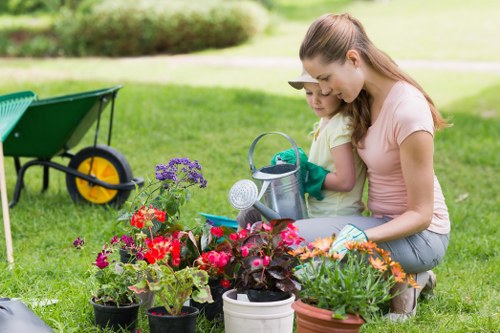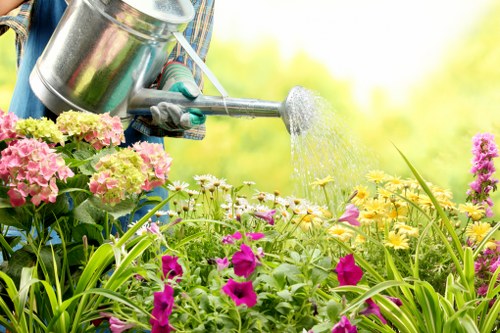Enhance Your Garden with a Fence Replacement Archway

Gardens are more than just outdoor spaces; they are sanctuaries for relaxation, beauty, and personal expression. One way to elevate your garden’s aesthetic and functionality is by installing a garden fence replacement archway. This feature not only provides structure and security but also adds a touch of elegance and charm to your outdoor area.
Whether you’re looking to replace an old fence or add a new element to your garden, a replacement archway can transform the entire look and feel. It serves as a focal point, guiding visitors through your garden while offering support for climbing plants and vines.
In this article, we will explore the benefits, styles, materials, and installation tips for garden fence replacement archways. Additionally, we’ll cover local considerations for those in Archway and surrounding areas.

Why Choose a Garden Fence Replacement Archway?
Replacing a garden fence with an archway offers numerous advantages. Here are some key reasons to consider this upgrade:
- Enhanced Curb Appeal: An archway can significantly improve the look of your garden, making it more appealing to visitors and potential buyers.
- Structural Support: Ideal for supporting climbing plants like roses, ivy, or wisteria, an archway adds vertical interest to your garden.
- Privacy and Security: A sturdy replacement archway can offer additional privacy without completely blocking views, maintaining an open feel.
- Customization: Available in various styles and materials, you can tailor the archway to match your garden’s theme and your personal taste.

Choosing the Right Style for Your Archway
Traditional vs. Modern Designs
When selecting a garden fence replacement archway, the style should complement your existing garden and home architecture. Traditional designs feature ornate details, curved lines, and classic materials like wood or wrought iron. These are perfect for gardens with a timeless or romantic feel.
Modern archways, on the other hand, emphasize clean lines, minimalist designs, and contemporary materials such as aluminum or steel. They are ideal for gardens that follow a sleek, modern aesthetic.
Custom vs. Pre-made Archways
Custom archways offer personalized dimensions, designs, and materials to perfectly fit your garden’s unique needs. Pre-made archways are more affordable and come in standard sizes and styles, making them a practical choice for many homeowners.

Materials for Garden Fence Replacement Archways
The material you choose for your archway affects its durability, maintenance, and appearance. Here are some popular options:
- Wood: Natural and versatile, wood can be painted or stained to match your garden’s color scheme. However, it requires regular maintenance to prevent rot and weather damage.
- Metal: Wrought iron and steel offer strength and longevity with minimal maintenance. They can be designed with intricate patterns for added visual interest.
- Vinyl: Low-maintenance and weather-resistant, vinyl archways come in various colors and styles. They are an excellent choice for those seeking durability without the upkeep.
- Aluminum: Lightweight and rust-resistant, aluminum is a practical choice for modern garden designs. It is easy to install and requires little maintenance.
Sustainable Options
For environmentally conscious gardeners, sustainable materials like bamboo or reclaimed wood can add a unique and eco-friendly touch to your archway. These materials are not only sustainable but also offer a distinct aesthetic.

Installation Tips for Your Archway
Planning and Preparation
Before installing a garden fence replacement archway, careful planning is essential. Consider the following steps:
- Measure the Space: Ensure you have adequate space for the archway and any plants you plan to support.
- Choose the Location: Select a spot that enhances your garden’s flow and provides optimal support for climbing plants.
- Check Local Regulations: Verify any local building codes or homeowner association guidelines before installation.
Installation Process
The installation process varies depending on the material and design of the archway. Generally, it involves:
- Foundation: Secure the base by digging holes and setting posts in concrete for stability.
- Assembly: Follow the manufacturer’s instructions for assembling the archway components.
- Securing: Ensure all parts are securely fastened to withstand weather conditions and daily use.
Maintaining Your Garden Fence Replacement Archway
Proper maintenance extends the life of your archway and keeps it looking great. Here are some maintenance tips based on different materials:
Wood Archways
Regularly inspect for signs of rot or insect damage. Apply a fresh coat of paint or stain every few years to protect the wood from the elements.
Metal Archways
Check for rust or corrosion, especially in humid climates. Clean and paint metal surfaces as needed to prevent deterioration.
Vinyl and Aluminum Archways
These materials require minimal maintenance. Simply wash with soap and water to remove dirt and debris.
Integrating Plants with Your Archway
Enhancing your archway with plants creates a lush, inviting space. Here are some plant ideas that work well with garden fence replacement archways:
- Climbing Roses: Add romantic beauty and fragrance.
- Ivy: Provides evergreen coverage and a classic look.
- Wisteria: Offers stunning, cascading blooms.
- Sweet Peas: Bring vibrant colors and delightful scents.
Ensure that the plants you choose are suitable for your climate and the specific conditions of your garden, such as sunlight and soil type.
Training Plants
Regularly guide and secure your plants to the archway to promote healthy growth and maintain the desired shape. Use plant ties or clips to gently attach stems without causing damage.
Cost Considerations for Garden Fence Replacement Archways
The cost of installing a garden fence replacement archway depends on several factors:
- Material: Wood and metal are typically more expensive than vinyl or aluminum.
- Size and Design: Larger and more intricate designs cost more due to additional materials and labor.
- Labor Costs: Professional installation ensures stability and proper assembly but adds to the overall cost.
- Maintenance: Consider long-term maintenance costs associated with different materials.
On average, homeowners can expect to spend between $300 and $1,500 on a garden fence replacement archway, depending on these factors.
Budget-Friendly Tips
If you’re on a tight budget, consider:
- Opting for a pre-made archway instead of a custom design.
- Choosing less expensive materials like vinyl or aluminum.
- Installing the archway yourself to save on labor costs.
Local Considerations in Archway and Surrounding Areas
If you reside in Archway or nearby areas, there are specific local factors to consider when replacing your garden fence with an archway:
- Climate: Archway experiences temperate weather, so choose materials that withstand both humid summers and cold winters.
- Local Flora: Select plants that thrive in the region’s climate to complement your archway.
- Community Aesthetics: Ensure your archway design aligns with local architectural styles and community guidelines.
Nearby Areas to Archway
- Southgate Known for its lush gardens, Southgate residents often opt for wood archways with climbing roses.
- East Barnet Modern metal archways are popular here, complementing the area's contemporary homes.
- Totteridge: Totteridge gardeners prefer classic wrought iron designs that add timeless elegance.
- New Barnet Vinyl archways are favored for their low maintenance and durability.
- Mill Hill Sustainable materials like bamboo and reclaimed wood are popular among environmentally conscious homeowners.
- Monken Hadley Historical homes in Monken Hadley often feature ornate wood archways to preserve the area's character.
- Chipping Barnet: Climbing wisteria on archways is a common sight, adding vibrant color to gardens.
- High Barnet: Aluminum archways are chosen for their sleek appearance and minimal upkeep.
- Whetstone Iron archways with intricate designs blend well with Whetstone’s residential landscape.
- East Finchley Residents here enjoy customizable archways that reflect their personal style and garden themes.
Conclusion
A garden fence replacement archway is a valuable addition that enhances both the beauty and functionality of your outdoor space. By carefully selecting the right style, material, and plants, you can create a stunning focal point that reflects your personal taste and complements your garden’s natural surroundings.
Whether you’re in Archway or one of the surrounding areas, understanding the local climate and community aesthetics will help you choose an archway that not only looks great but also stands the test of time. With proper installation and maintenance, your garden fence replacement archway will provide years of enjoyment and elevate your garden’s charm.
Take the time to plan and invest in a quality archway, and transform your garden into a beautiful and inviting haven.
Frequently Asked Questions
1. How long does it take to install a garden fence replacement archway?
The installation time varies based on the complexity of the design and the material used. On average, a professional installation can take between one to three days.
2. Can I install a garden fence replacement archway myself?
Yes, with the right tools and instructions, a DIY installation is possible, especially for pre-made archways. However, complex designs or heavy materials may require professional assistance to ensure stability and safety.
3. What maintenance is required for a wooden archway?
Wooden archways need regular maintenance, including staining or painting to protect against moisture and pests. Inspecting for signs of wear and treating any damaged areas promptly is essential to maintain durability.
4. Which materials are best for wet climates?
Metal archways like galvanized steel or aluminum are ideal for wet climates due to their resistance to rust and corrosion. Vinyl is also a good low-maintenance option.
5. How can I prevent my climbing plants from damaging the archway?
Regularly trim and guide your climbing plants to ensure they grow along the archway without causing stress or damage. Using plant ties or clips can help maintain the desired growth pattern.